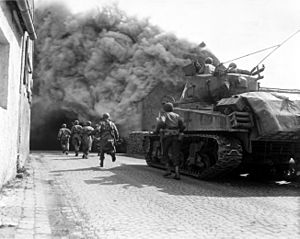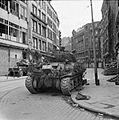Western Allied invasion of Germany facts for kids
Quick facts for kids Invasion of Germany |
|||||||
|---|---|---|---|---|---|---|---|
| Part of the Western Front of World War II | |||||||
 United States Army soldiers supported by a tank move through a smoke filled street in Wernberg, Germany during April 1945 |
|||||||
|
|||||||
| Belligerents | |||||||
|
Western Allies |
|||||||
| Commanders and leaders | |||||||
|
|||||||
| Units involved | |||||||
|
Army Group G |
||||||
| Strength | |||||||
| 4,5 million troops (90 Divisions) | ~1,000,000 troops | ||||||
The Western Allied invasion of Germany was a major attack on Nazi Germany by the Western Allies. It happened in the last months of World War II in Europe. The invasion began when Allied forces crossed the Rhine River. They then moved quickly through western Germany. The German forces surrendered on May 8, 1945. In the United States, this event is known as the "Central Europe Campaign."
By early 1945, the Allied forces in Europe were doing very well. On the Western Front, the Allies had been fighting in Germany since October 1944. In January, the Allies defeated the Germans in the Battle of the Bulge. This was Germany's last big attack, and its failure greatly weakened their army. Germany could not do much to stop the final Allied attacks.
The German army lost many soldiers in the Rhineland battles. This left very few troops to defend the east side of the Rhine River. By mid-March, the Allies had captured a bridge at Remagen that was still standing. They also held the area on the river's east bank.
During the Allied attacks to reach the Rhine in February and March 1945, Germany lost about 400,000 soldiers. About 280,000 of these were taken as prisoners of war.
On the Eastern Front, the Soviet Red Army had moved through Poland. They were getting close to Berlin. The Soviets also advanced into Hungary and eastern Czechoslovakia. These attacks on the Eastern Front destroyed many experienced German army groups. This made it very hard for Adolf Hitler to make his Rhine defenses stronger.
Contents
Military Forces Involved
Allied Armies
At the start of 1945, General Dwight D. Eisenhower was the Commander of the Allies. He had 73 divisions in North-western Europe. This included 49 infantry divisions, 20 armored divisions, and four airborne divisions.
When the invasion of Germany began, Eisenhower had 90 divisions. This included 25 armored divisions. It was one of the largest forces ever seen in a war. The Allied line along the Rhine River stretched about 450 miles (724 km). The Allies wanted to capture the important industrial area called the Ruhr.
German Armies
The German forces facing the Allies were led by Field Marshal Albert Kesselring. He was in charge of "Army Command West."
Kesselring was known for being good at defending land, especially during the Italian Campaign. However, in Germany, he did not have enough soldiers or weapons to put up a strong defense.
During the fighting west of the Rhine up to March 1945, the German Army on the Western Front had only 26 divisions. Most of Germany's troops were fighting against the Soviet forces. In April, the Germans had 214 divisions on the Eastern Front.
Allied Battle Plans
After capturing the Ruhr, Eisenhower's original plan was for the 21st Army Group to move east toward Berlin. However, he started to change his plans in late March. He learned that Soviet forces had already crossed the Oder River, which was only about 30 miles (48 km) from Berlin. He worried the Soviets might capture Berlin before the Western Allies.
Eisenhower was also concerned about the Ruhr area. It had many German troops and a lot of factories. He was also worried about the "National Redoubt." Some people believed Hitler's most loyal soldiers were getting ready to defend themselves in the mountains of southern Germany and western Austria.
American forces in the south were fighting very hard and winning. On March 7, Lt. Gen. Courtney Hodges's 1st Army captured a bridge over the Rhine at Remagen. This was a big advantage.
To the south, in the Saar-Palatinate region, Lt. Gen. George S. Patton's 3rd Army had defeated the German 7th Army and the German 1st Army. From March 18 to 22, Patton's forces captured over 68,000 German soldiers.
Taking Control of Towns
When Allied soldiers arrived in a German town, the local leaders and people often used white flags to show they wanted to surrender. The Allied officer would then take control of the town. Soldiers would put up posters of Eisenhower's Proclamation No. 1.
This poster told Germans that they had to follow orders from Allied officers. It also said people could not go out at night or travel without permission. It stated that Germans had to give all their weapons to the Allies.
Images for kids
-
Douglas C-47 transport aircraft drop hundreds of paratroopers on 24 March as part of Operation Varsity.
See also
 In Spanish: Invasión de los Aliados occidentales de Alemania para niños
In Spanish: Invasión de los Aliados occidentales de Alemania para niños










